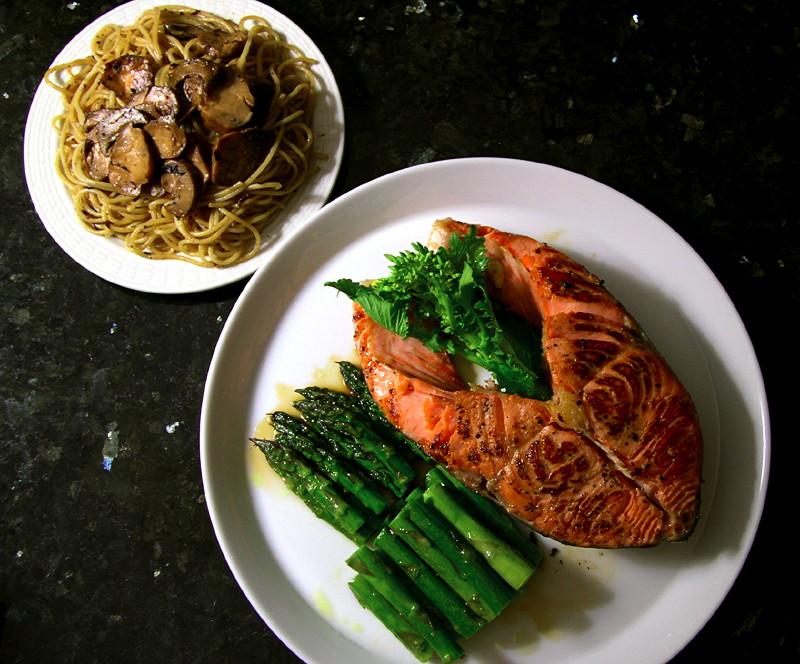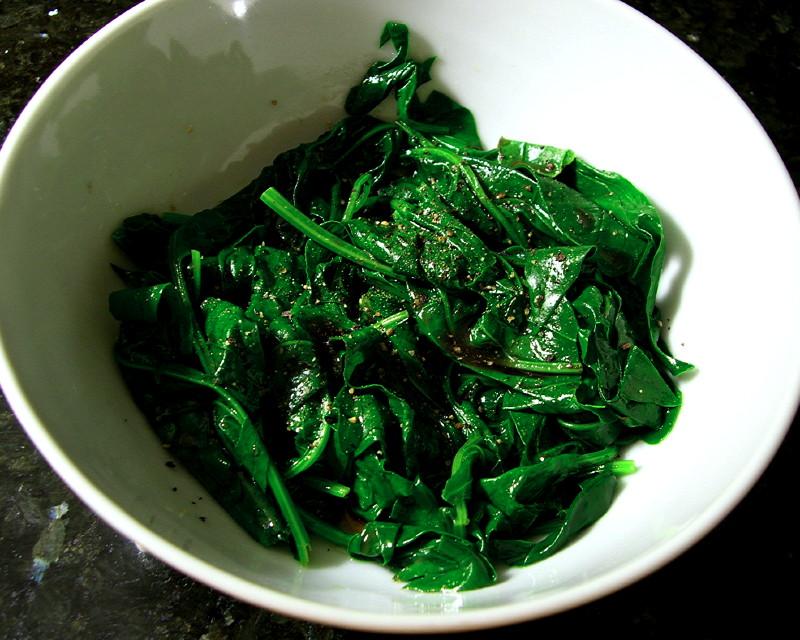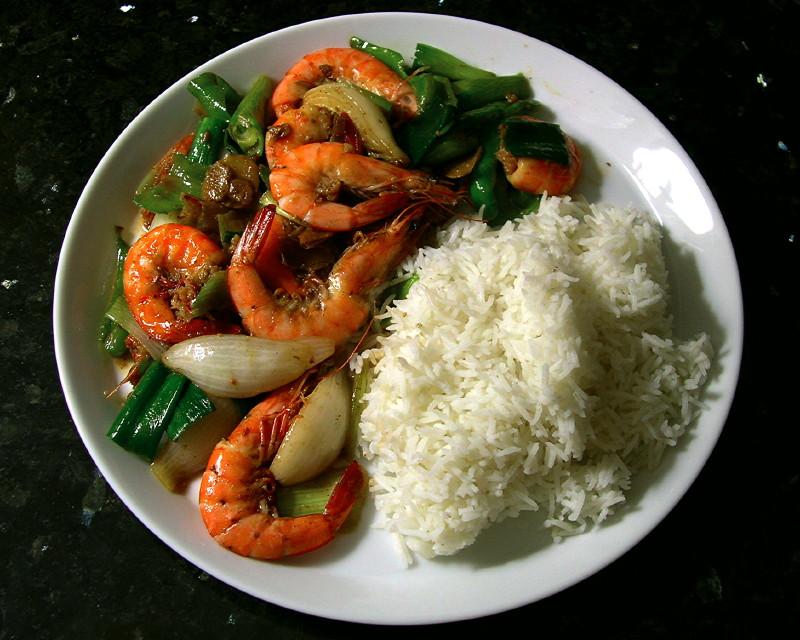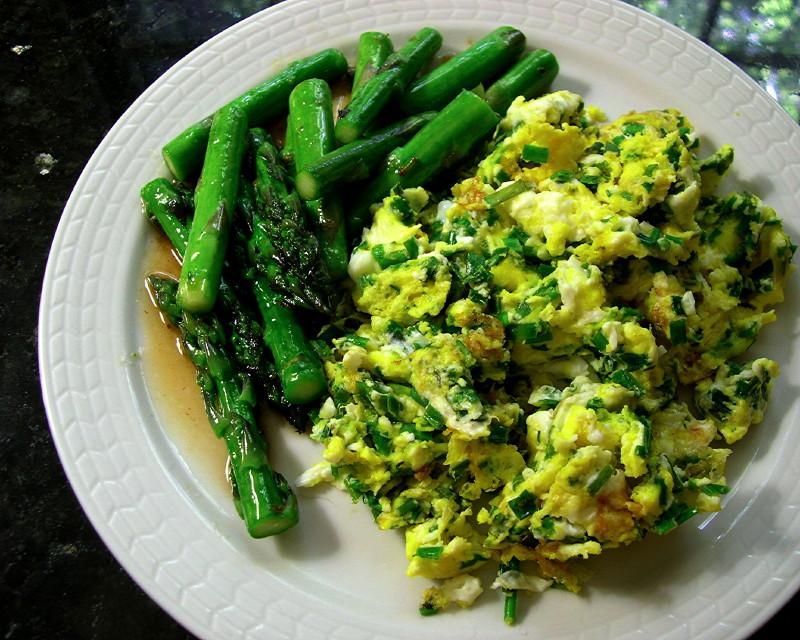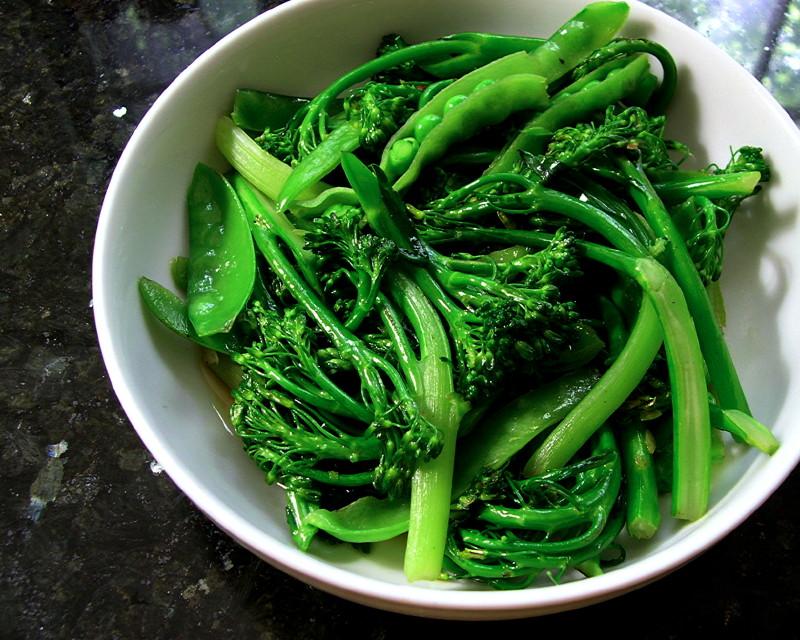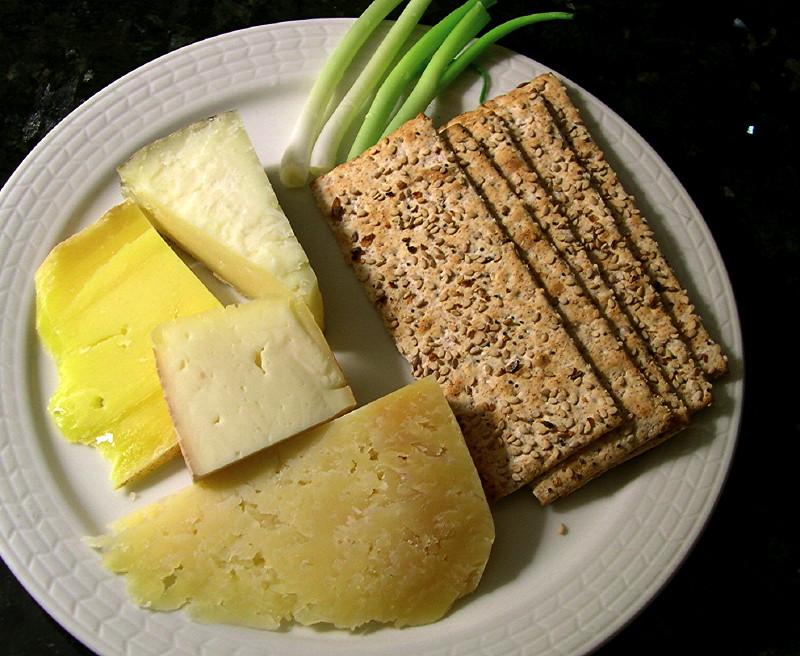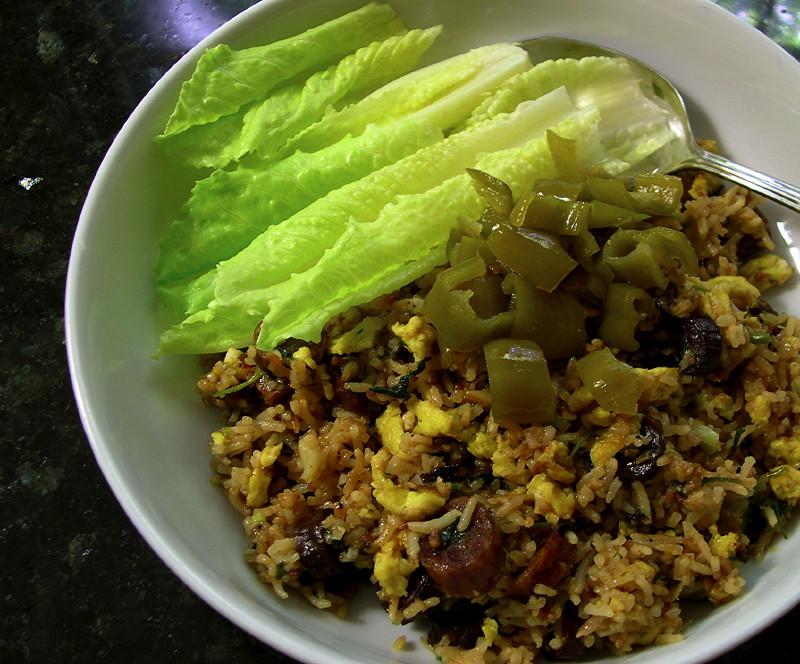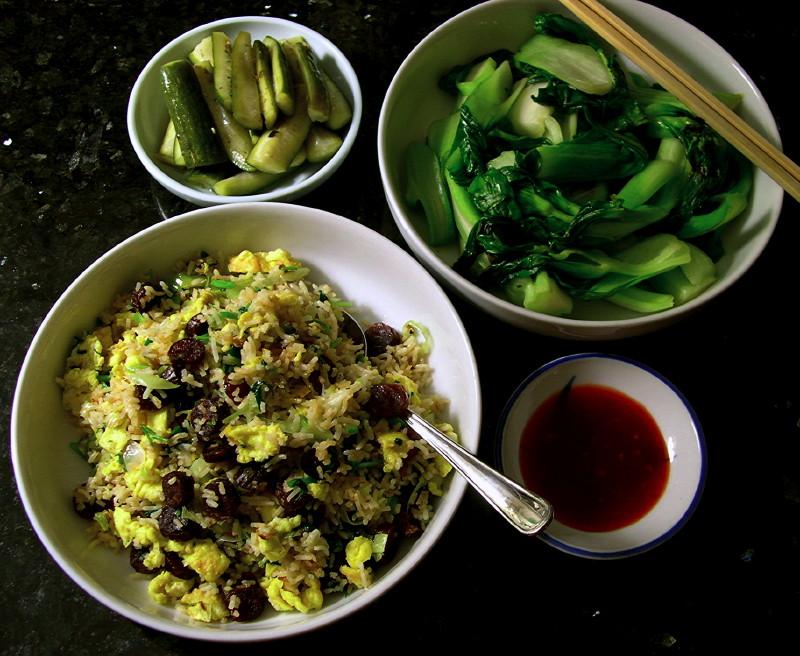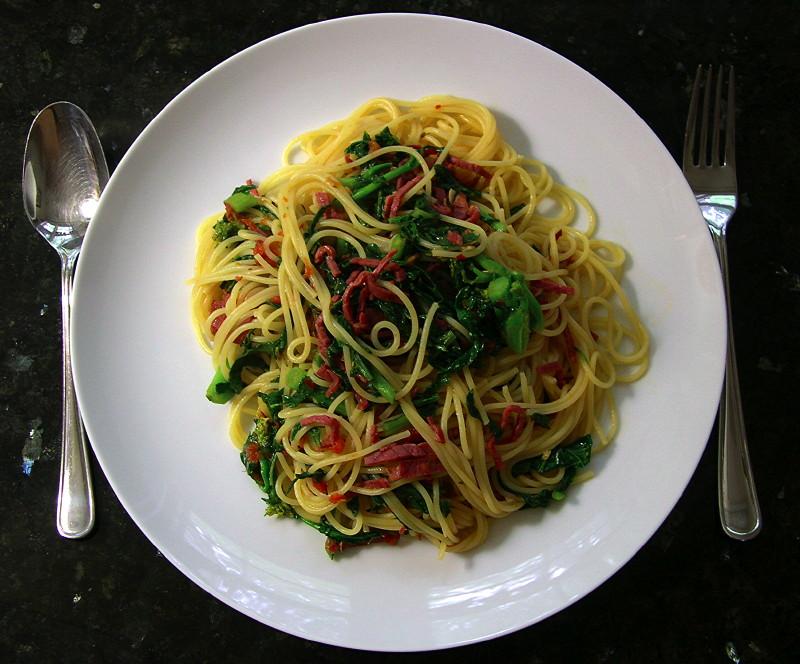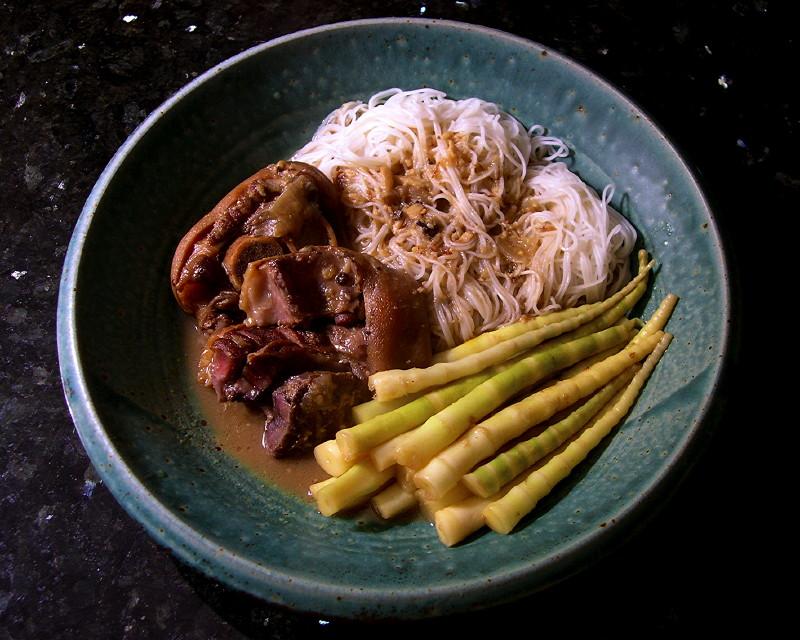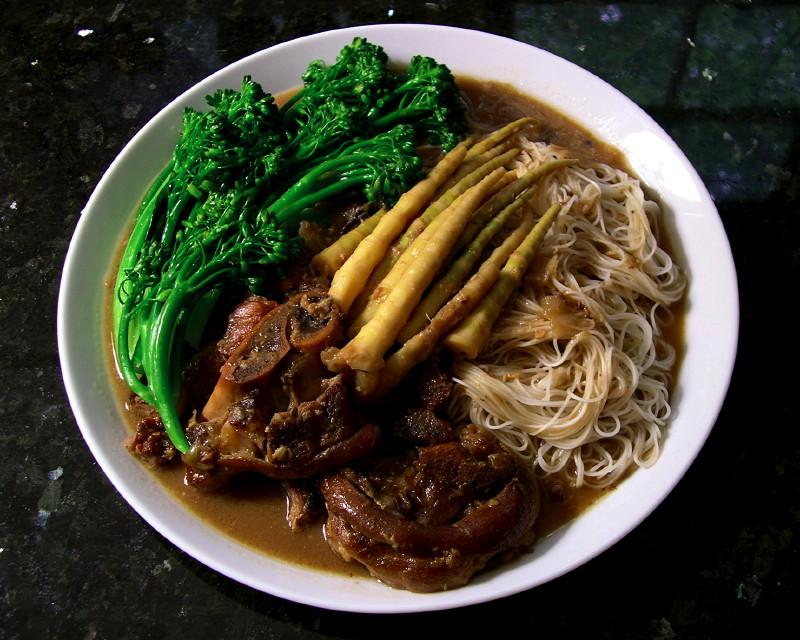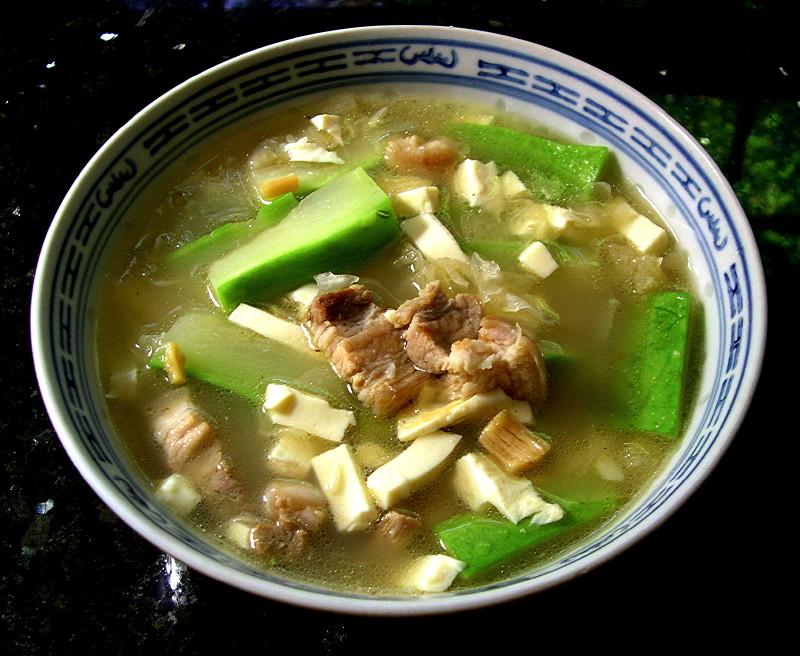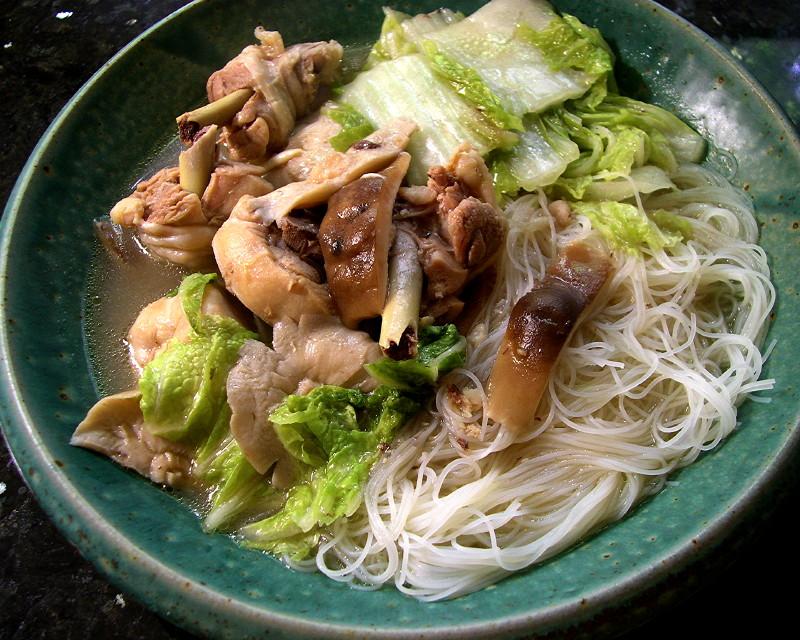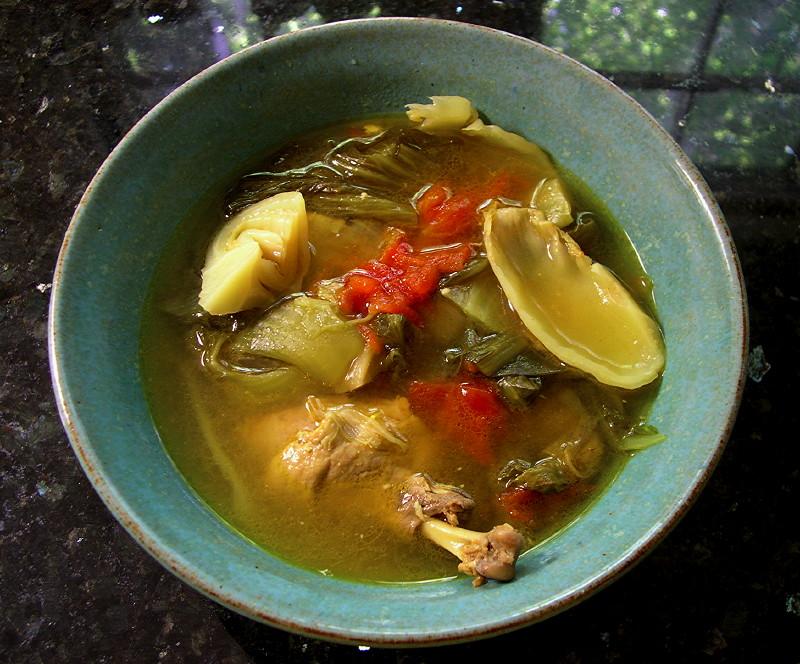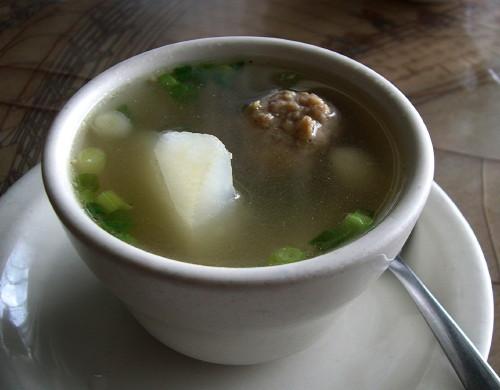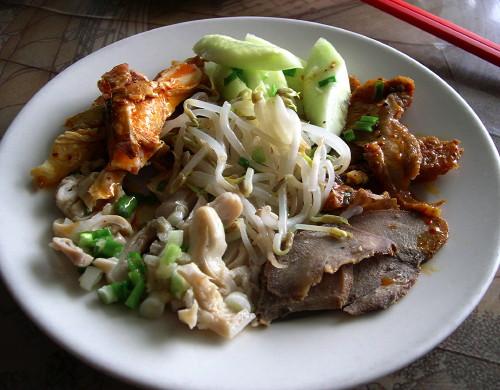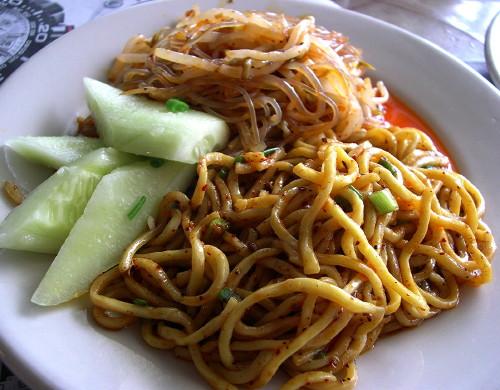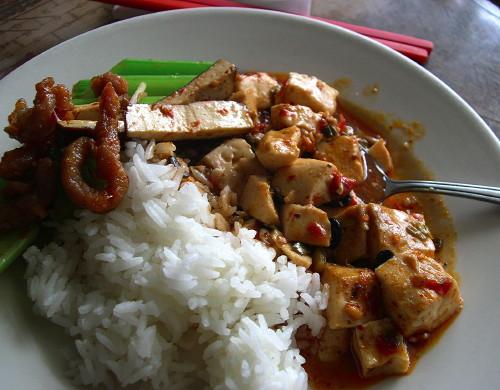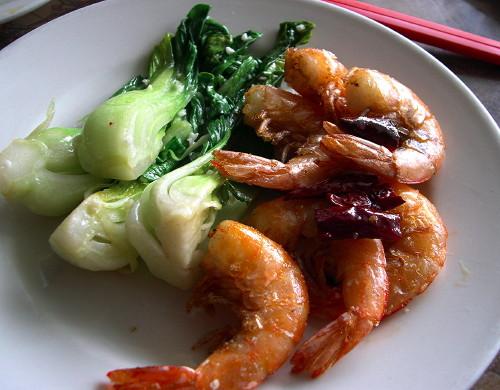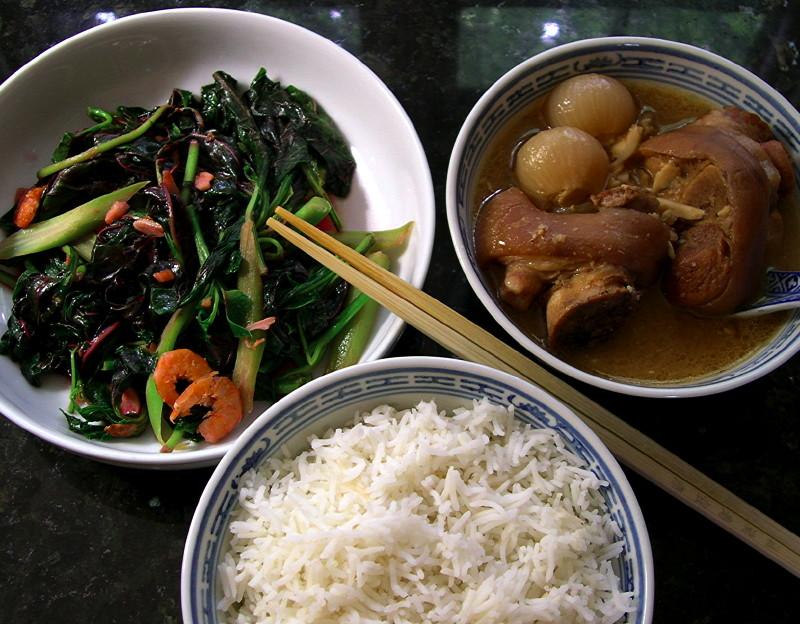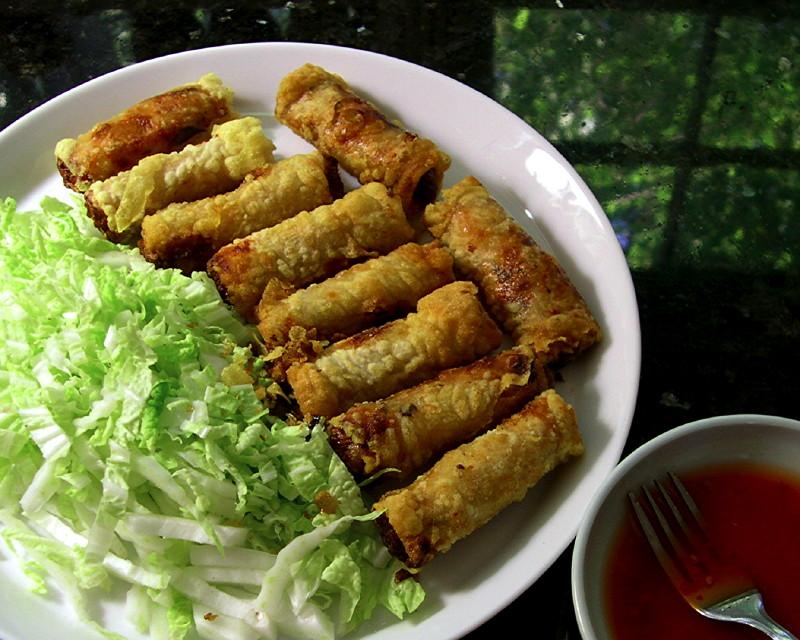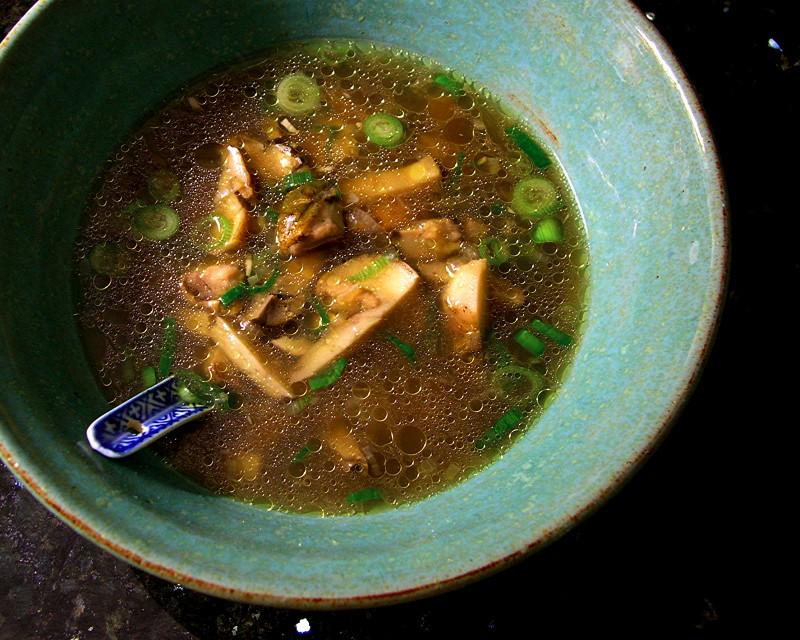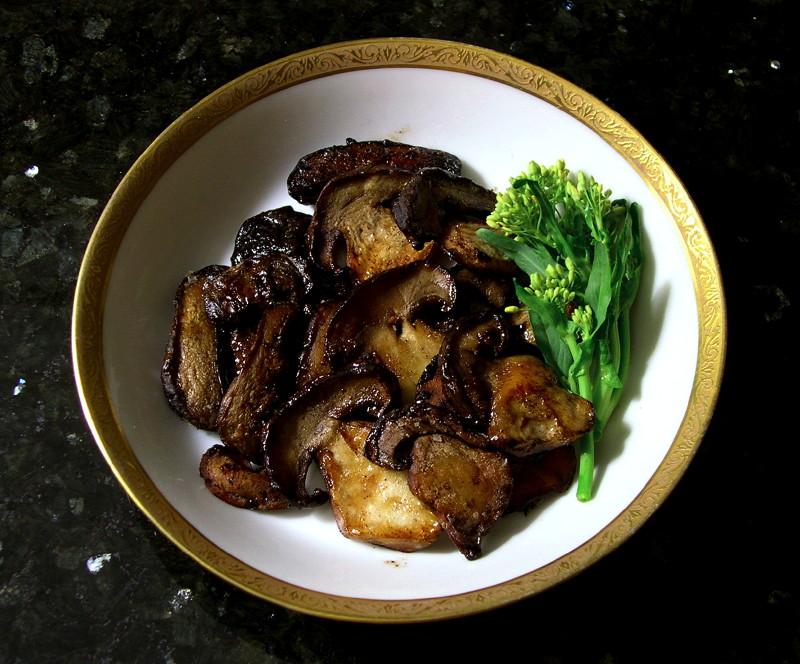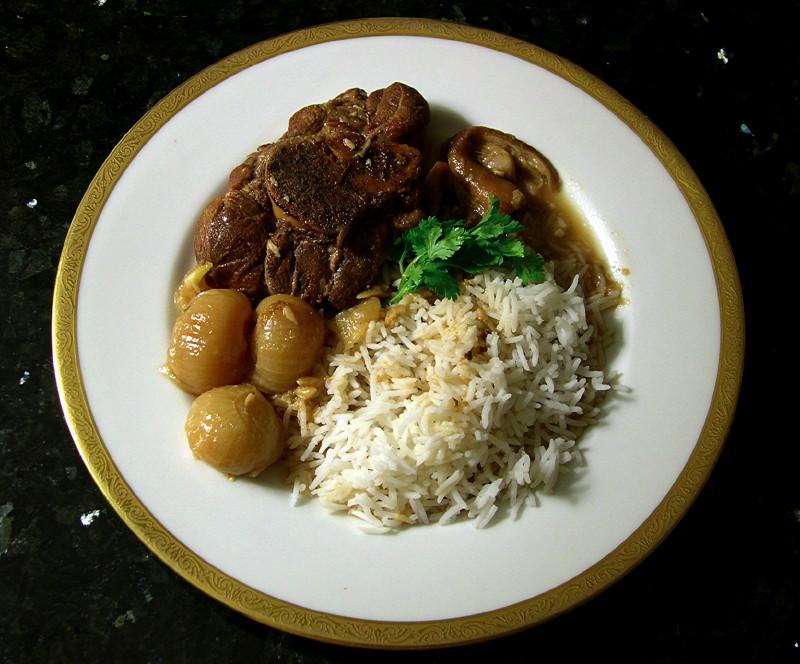-
Posts
3,810 -
Joined
-
Last visited
Content Type
Profiles
Forums
Store
Help Articles
Everything posted by huiray
-
I've done it, with chicken eggs, but I do it the "quick scramble" way, not the French slow-cooked way. I like it. Or with fried rice (so the eggs are scrambled in situ) like here. :-)
-
I don't cook duck as often as I should. For one, it is more expensive here in the USA, and secondly it's harder to find fresh ducks than fresh chickens. No, I don't go shooting for wild game. I frequently eat Cantonese roast duck, nevertheless. I don't really cook it myself, I get it from the Chinese grocery store or from Chinese restaurants or from Chinese "charcuterie shops" (certainly almost always when I swing through Chicago I would do so). Haven't had Peking Duck in a while. I don't subscribe to the notion that roast duck MUST have crispy skin with all fat rendered out.** A couple examples of my recent use of duck (parts): http://forums.egullet.org/topic/147265-dinner-2014-part-2/page-16#entry1962535 http://forums.egullet.org/topic/147265-dinner-2014-part-2/page-19#entry1967706 which is a classic combination and, I guess, variations on Itek Tim as it would be called in Nyonya cuisine. ** That Cantonese roast duck, for example, will not have crispy skin. Ditto other styles like Tea-smoked Duck. They may have some crispy-like texture in some cases, but not the "shatteringly-crisp" skin that some folks in other traditions might seek. They will also have a layer of fat between the skin and the flesh, varying from slight to significant. Peking Duck should have crispy skin, of course. Braised duck dishes will, by default, have non-crispy skin. ;-) ) ETA: Many folks here on eG have described duck dishes using duck breasts and other duck parts, and some have also done so on this thread. I don't see a restriction here on this thread to discussing *only* whole ducks - is there?
-
• Sautéed asparagus. • Pan-fried King salmon steak. (pre-marinated: salt, black pepper, key lime juice, ripe calamansi juice, ryori-shu, hon-mirin) • Spring porcini sautéed in the pan residues. • Fedelini tossed in the pan w/ the deglazed fond & pan residues w/ the porcini.
-
A late dinner. Spinach blanched in oiled hot water (in a pyrex bowl) then drained, re-bowled & dressed w/ ponzu sauce & ground white pepper. Shell-on head-on prawns (salt-water farmed, Indiana), pan-fried w/ garlic, ginger, young candy onion w/ its lower green parts, Redmond salt, generous white pepper, hot long green chillies. The prawns were pre-marinated w/ some kan sui (K2CO3 + NaHCO3) diluted w/ some water, plus some sugar; then rinsed.
-
• "Marbled" scrambled farm eggs w/ chopped Western chives, simply salted.§ • Asparagus sautéed in corn oil, splashed w/ hon-mirin [Takara] & ryori-shu [Morita] and cooked on high heat to glaze the asparagus.¶ • Broccolini & snow peas "sautéed"/flash-fried w/ chopped smashed garlic, corn oil & salt. (p.s. None of the veggies were pre-blanched. The broccolini & snow peas were tossed into a very hot pan (with hot oil in it; garlic preceeding the veggies by 5 seconds or so) and the pan covered within the second - one does this by placing the damp veggies in the upside-down cover, then inverting them into the pan and closing the lid down immediately. The pan, still closed, is shaken with one hand holding the lid on, for a short while before taking the lid off. A splash of water is added, the pan re-covered for a short while. The pan is uncovered, stuff tossed, and immediately plated when done. High (gas) flame throughout. The whole process takes maybe 3 minutes or so (or less). Pictures are not really possible through this process, unless someone else is standing by to take them. :-) Additionally, in both veggie preps the aim was "sufficiently cooked" but definitely still crunchy.) ¶ The mirin has a whole range of sugars in it plus alcohol. The sake (ryori-shu) has salt in it as well as the alcohol. § Yes, the eggs are purposely allowed to brown in spots and it is desired that it occurs.
-
Nah. I like it a lot but the two were not in the least complementary. The pakora would have been better "naked". Two articles on flavor pairing: http://www.nature.com/srep/2011/111215/srep00196/full/srep00196.html http://specertified.com/blog/view/flavor-pairings-the-science-of-flavor
-
A cheese plate for dinner. Left, top to bottom: Pecorino Toscano, Tarentaise [Thistle Hill], Taleggio [Ciresa], Kenny’s Reserve Asiago. Scallions, sesame seed Lavash crackers. The Tarentaise was new to me. I liked it very much. Eating it side-by-side with the Asiago (which was very nice itself) was quite interesting.
-
Friday-Saturday foodstuff shopping: Goose the Market Kenny’s Reserve Asiago, Pecorino Toscano, Taleggio [Ciresa], Tarentaise [Thistle Hill] cheeses. Lamb bacon [smoking Goose]. King salmon steak, bone-in. BRFM (Broad Ripple Farmers’ Market) Chicken-of-the-woods mushroom. Tuscan kale (whole young head). Spinach, quite beautiful! Snow peas. Sugar snap peas. Broccoli rabe. Farm eggs. Cherokee Purple tomatoes. Young/baby garlic heads. Purple, yellow, chartreuse, green cauliflower & broccoli florets. Binford Farmers’ Market Asparagus. Spring onions. Fresh head-on shell-on shrimp (technically prawns, from the anatomy), from an Indiana salt-water shrimp/prawn farm; via Caplinger’s Fresh Catch. These were harvested yesterday.
-
• Leftover lap cheong fried rice. With some romaine heart leaves and pickled (chopped) hot lo0ng green chillies. • Romaine blanched in oiled hot water,¶ drained, drizzled w/ oyster sauce & dusted w/ ground white pepper. ¶ See here for some chit-chat on doing veggies this way.
-
For myself I do not do what Soba did. I almost never blanch my vegetables first when sautéeing (or stir-frying) them, with some exceptions depending on what I am doing or what I want to achieve. Leafy veggies never get blanched first. If I blanch my leafy and soft vegetables (like the spinach that Soba used) then it is purely for wilting it and just barely cooking it (wilted with a slight darkening of color = cooked, in my books) but in OILED hot water; followed by draining it and tossing with oyster sauce, ponzu sauce, etc...plus a grind of pepper... and eating it forthwith. I've described this in many posts here. With me, the washed spinach would go straight into the very hot pan (stainless steel, not non-stick pans) preheated before adding any oil at all. The garlic goes in, followed by the spinach very quickly after. It's tossed around a bit with the spatula (again, hot pan, full flame) and it wilts down and cooks in no time flat. Done. For myself, if I were to blanch the spinach first, wring it out, then sauté it the result would be too mushy and soft for my tastes. When cooking harder stuff (like broccoli florets) they also go in without pre-blanching, again into a very hot pan (preheated before adding oil) but I would then COVER the pan for an appropriate amount of time. Even with the spinach I might do so briefly, so as to return the aromatics that come off in the first couple of seconds back to the pan. (Very hot pan + very hot oil + wet vegetables = a WHOOSH and immediate roar of vapors. Covering it within the second the veggies go in traps those aromatic vapors and returns them to the pan and food being cooked) With appropriate wetness/dryness and covering one also achieves a tasty browning of the veggies (this is especially nice with green beans) while cooking the stuff through. A splash of additional water may or may not be called for, again depending on the circumstances. One could consider it a partial "steaming" of sorts being a part of the process, yes. In a sense this is reminiscent of what Weinoo mentioned upthread. There are elements of stir-frying in this. I add pasta to the dish at the end, when I am aiming for such a dish and with appropriate ingredients (meats and other proteins may become ingredients in the progression of the process) to generate the kind of dishes the OP described in his initial post. I've described such dishes here on eG as well. (Some recent examples here, here, here, and here; various others hither and yon.) In a related sense, it is certainly true that in stir fries "hard" vegetables (like that broccoli, kai lan, big pieces of bok choy, carrot pieces, etc) get blanched first in the wok with some boiling water. They are then sieved out and may or may not be shocked by cold water (not iced), the wok cleaned out, the rest of the stir fry commenced on and the veggies added back in at the appropriate time. If one watches an open kitchen in a Chinese restaurant (or your friendly neighborhood Chinese take-out) one can see this being done. :-) ((Shrug)) Different strokes for different folks. As Soba alluded to, there is no single way to do this.
-
Fried rice.¶ Shanghai choy sum - simply cut-up and stir-fried w/ salt & oil in a very hot pan. Pickled cucumbers (rice vinegar, salt, hon-mirin, toasted sesame seeds, wasabi fumi furikake). Lingham's Thai hot sauce. ¶Liver lap cheong & "grain alcohol flavor" lap cheong were steamed, then cut into thick rounds. The steaming liquids & exuded oil were also reserved. Two eggs were beaten w/ some oil, ground white pepper, diluted w/ some water then fried in a very hot pan w/ hot oil to make a bubbly "flattish" simple omelette, cut into thick strips and reserved. Chopped garlic was tossed into a very hot pan & oil followed by the cut-up lap cheong pieces less than 10 seconds later. Sliced negi followed. Then 3-day-old rice, plus the reserved lap cheong steaming liquids. (Tossing around - spatula - as needed, letting "sit" as needed) Thinly sliced scallions plus the reserved cut-up omelette followed. Tossed/stirred/mixed well. Heat shut off, pan covered and the whole thing allowed to sit for a minute or two.
-
The way I make my soft boiled eggs is typically to pour hot water (i.e. from the kettle after the water in it has boiled) onto eggs (frequently straight from the fridge, so they are still cold) in a small pan to cover the eggs plus a bit more, cover them, and simply wait about 10 minutes. This works fine. In fact, if the eggs are at room temperature or, especially, if I have pre-warmed them with hot water from the tap, they turn out overcooked (whites and yolks solidifying) after 10 minutes standing (i.e. no additional fire/heat from the stove or whatever) and I need to dump the water out after 7-8 minutes and run cold water over the eggs if I want something liquidy. In cases where I have used less-than-optimal amount of hot water and used very large cold eggs for less than 10 minutes or so I will get snotty eggs with uncooked whites but that is still fine by me - I am not obsessive about this and have a wide tolerance about the degree of "done-ness" of my eggs. I drink the snotty eggs just the same. If you did use a coffee mug, put the two eggs into it and pour the hot water from the pot of hot water into it (i.e. there was barely enough water to cover the eggs and the volume of same would be that small amount limited to a coffee mug) then yes, you would need to dump the water after a few minutes and add more hot water again (even maybe yet again) otherwise you *will* get very snotty eggs. So - get a large pot of hot water, if you can't get a *large" mug of very hot water in a diner or some such place.
-
:-) True. A soufflé is unlikely, for example, but steamed trembling egg custards or fried eggs of various sorts (besides said soft boiled eggs) would be possibilities. ;-) Would you consider tan tats (those egg-custards-in-a-flaky-pastry-cup things) as qualifying? :-D
-
Just break them into a bowl or mug and simply drink them. I do. Like these. :-)
-
Since you are citing NYC places, you forgot various shops and bakeries in Chinatown in NYC - or in other Chinese communities elsewhere (in North America, which this conversation seems to be limited to, by default and/or assumption, without it actually being specified...). You can indeed get breakfast in those places, commonly. Plus eggs in some. (What about dim sum? ;-) ) If the O.P. were to live in E/SE Asia instead, he would have little difficulty getting his boiled eggs (usually soft boiled, in this case) from any number of shops or kopitiams (SE Asia), together with kaya toast. Standard breakfast items. Consumed by folks of all ages from all walks of life. To the O.P. - I wonder if you were to go to a diner and ask them for a big mug of boiling/hot water and a couple of eggs - would they oblige? Just dunk the eggs into the hot water, cover with something, drink your coffee, and about 10 minutes later crack those eggs into a mug (or cereal bowl or other bowl) and have your soft-boiled eggs. Eh, if the water isn't really hot enough you might get some slightly snotty eggs - but for myself they would go down the hatch just the same and just fine.
-
Pretty common in Muslim countries and in halal communities. If you have "Bacon & Eggs" in a restaurant in a hotel that wants to do business with the govt in Malaysia, for example, you are likely to get beef bacon which must also have been certified as scrupulously "halal". The cut that is used varies depending on who is making it and so on, but frequently the beef navel is used. "Beef belly". :-) Brisket is also used, and sometimes other cuts too. One useful post (and thread...). Ask in a halal shop in your area (are you in the USA?) for "Breakfast Beef" and, if they have it, ask them which cut was used. Have you considered lamb bacon? I think that is more scrumptious than beef bacon. Usually made from, yes, lamb belly :-) in the US. Some folks (like this fellow, amongst others) uses the saddle. Smoking Goose, in my area, uses the belly (sold through its sister shop Goose the Market). ETA: The Beef Bacon Corporation (in Canada) (google it) claims to be the world's largest supplier of the stuff (and also claims to have invented it (??!!)) (N.B. I have no financial or other interests in that company) ETA2: Kosher lamb bacon appears to be available.
-
Lunch a couple of days ago: A sauté of garlic, olive oil, corned beef slices cut into strips, chunked tomatoes, chopped broccoli rabe, a splash of ryori-shu; then separately cooked fedelini [De Cecco], tossed in the pan with the heat turned down to medium.
-
Braised pork hocks - leftovers from here - were refired/augmented w/ bamboo shoots, the seasoning & sauce volume fiddled with a bit etc. Dinner - with min6 sin3 (mee sua). Lunch the next day - the rest of it, also with min6 sin3; plus blanched broccolini. ------------------------------------ Soup. Pork short-cut spare ribs plus sliced pork belly, sautéed w/ smashed garlic in corn oil; Redmond salt; water, dried scallops; simmer; snow fungus, simmer; Opo squash slices, simmer; soft tofu towards the end.
-
Thanks! Much appreciated. Reading it over - if I left out the almond powder would you think it would be deleterious? Perhaps pine nuts instead...just thinking out loud. Or no nuts. It's a clever dish nonetheless.
-
Could you say something more about this, if you could? Details, please?
-
Yes, it is annoying. In Chinese/Asian groceries they will tend to leave the fish "intact" - but in other places one needs to tell them specifically to leave the fins on. In the large "international market" here one has choices pictured in diagrams for folks (speaking various languages) to choose how they want their fish prepared. I once asked specifically for "intact fins all around, three slashes" (choosing the appropriate numbered picture) and the guy went and mangled it anyway by chopping off the fins before I could stop him...I refused the fish. Also, even apart from the aid the fins render in taking apart a fish, a finless/trimmed fish on a platter always seems to me to look mutilated, like an armless, legless murder victim on the coroner's bench. For myself, I don't find filleting of a whole fish to be needed and also find it to be wasteful. My 2¢. There is a lot of flesh and juicy stuff lost from scraping off all those belly bones, chopping off beyond the collarbone (see my comment above about yummy collarbone meat**), the pulling-off of the dorsal, ventral and pectoral fins...with a pair of chopsticks I would suck the flesh off those bones...:-) ** Hmm, I suddenly feel like going for some nice grilled hamachikama...
-
In those restaurants you have been to where you admired their dissection and serving of the fish did the fish have those slashes in them? If not there's your answer. For myself I find that undercooked fish (even a bit) tends to not "release" from the bone - especially if it is still just slightly red/pink (red, in the case of salmon bone-in steaks, for example) next to the bone. It will "tear", and come off in pieces with some slight force needed.** Overcooked --> comes off the bone fine but the rest tends to either crumble a bit, or be rubbery depending on the fish. Do you do E/SE Asian style meals at all? Consider eating the fish family-style in the E/SE Asian manner. Chopsticks. Serving spoon & serving fork if needed. Personal fork-and-spoon for folks who prefer them. Those slashes can be left in, no problem Everyone helps themselves to pieces of the fish as they eat along from the one platter on which the fish is presented, artfully arranged to your satisfaction. (Flip the fish over if you like; remove the central bone if you have superstitions about that) The video Franci posted shows a filleting and deboning of a branzino which is then, one might note, served still as "one fish" on the same platter, being carried to the table where one could speculate it will be eaten "family style", maybe? (And hopefully someone will pick out the fish cheeks, those two prized morsels that so many simply throw away with the rest of the head and the yummy collar-bone flesh as well...) ** ...and I tend to eat my whole fish with chopsticks anyway...
-
They look like very nice ones!** These "spring boletes" have been recognized as a separate species, Boletus rex-veris, now distinguished from the standard European porcini Boletus edulis (see here and here also) and considered to be indeed more delicate and less "strong" in taste but are also said to be quite firm and crunchy "especially in the button stage". The "fall boletes" from CA and the Pacific Northwest would be Boletus edulis, but now also recognized as a variety of the European ones. Did you have any issues with bolete fly larvae? ** I got some the other day too, also from Oregon, less pristine and a little more reddish than yours.
-
Some recent lunches. ----------------------------------------- Chicken legs, chopped up, braised (stove top) w/ sautéed garlic/corn oil, some sliced ginger, sliced-up fresh shiitake mushrooms, Shaohsing wine (VERY generous pour, maybe a one-third-cup's-worth), ryori-shu, rice vinegar, salt, some sugar in the form of mirin-fuu. Cut-up wong nga pak (Napa cabbage) went in just before the end. Eaten w/ mei fun (skinny rice noodles) simply softened in hot water. ---------------------------------------- A war-horse dish: Pickled mustard soup. This one was made w/ a duck leg quarter plus a couple of chicken legs. ---------------------------------------- Buffet brunch at Sichuan Restaurant, Carmel, IN. 1) Minced pork ball & daikon soup. 2) Various cold cuts & stuff: pickled cucumbers, chillied beef tripe, beef tongue, scallion pig maw, savory chitterlings, chillied chicken, pickled bean sprouts in the middle. 3) Chillied cellophane noodles w/ bean sprouts, sort-of dan-dan noodles, more pickled cucumbers. 4) Tea-smoked duck (not pictured) 5) Shell-on shrimp/prawns pan-fried w/ Szechuan chillies. Baby bok choy stir-fried w/ garlic. 5) Mapo tofu w/ white rice. Plus some chillied stir-fried pork strips w/ "hard" yellow-skin tofu & celery. ----------------------------------------- Stewed/braised pork hocks. See here for details. Red-streaked amaranth (yin choy) stir-fried w/ pre-softened dried shrimp & garlic. White rice.
-
Some recent dinners. ------------------------ An early dinner. Deep-fried chả giò tôm cua (Vietnamese spring roll w/ crab & shrimp). Eaten w/ wong nga pak (Napa cabbage) & Lingham's hot sauce mixed w/ aged rice vinegar. ------------------------ Late dinner. Simple fresh porcini soup. White parts and bulb of young candy onion sautéed in oil, fresh porcini added, salted, water added, simmered, green parts/leaves of the candy onion added right before the end. ETA: Oh, I also happily munched on slices of (store-bought) corned beef. :-) ------------------------ Another late dinner. Porcini slices sautéed in butter, splashed with hon-mirin [Takara], cooked till caramelizing. Salted lightly. Eaten w/ a few sprigs of broccoli rabe flowers. Braised/stewed pork hocks. Eaten w/ white rice. Pork hocks browned in garlic-infused oil (~ 2-heads-worth; reserved then added back in later); then cooked w/ mutenka shiro miso, aka miso, sufficient water, shallots, a stick of cinnamon, some cloves, a star anise.



